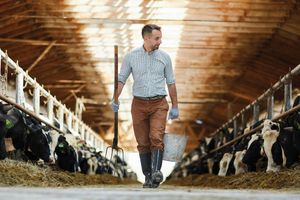Dairy Revenue Protection A Key Risk Management Component
Editor’s Note: This is the first in a two-part series about Dairy Revenue Protection. View part two to learn more about how it works and how ProAg can help integrate it into your operation.
 In recent years, the dairy industry has faced a volatile marketplace with a lot of downside risk. Bearish market prices and trends like consolidation have pressured revenue potential and inserted new risk into the industry. It’s a call for producers to integrate comprehensive risk management strategies like Dairy Revenue Protection to ensure viable future production.
In recent years, the dairy industry has faced a volatile marketplace with a lot of downside risk. Bearish market prices and trends like consolidation have pressured revenue potential and inserted new risk into the industry. It’s a call for producers to integrate comprehensive risk management strategies like Dairy Revenue Protection to ensure viable future production.
Dairy Revenue Protection (DRP) is a fundamental component of such a strategy for producers and their industry partners like feed suppliers, nutritionists and cooperatives that manage milk and other product sales.
The program provides a price floor and insures against “unexpected declines in the quarterly revenue from milk sales relative to a guaranteed coverage level,” according to the U.S. Department of Agriculture (USDA) Risk Management Agency (RMA). Those coverage levels range from 80% to 95%, with subsidies available for farmer-paid premiums ranging from 44% to 55%. There are some limitations to coverage.
“Dairy Revenue Protection provides insurance for the difference between the final revenue guarantee and actual milk revenue, times actual share and protection factor, caused by natural occurrences in market prices and yields in the pooled production region,” according to USDA-RMA. “Dairy Revenue Protection does not insure against the death of dairy cattle, other loss or destruction of your dairy cattle or any other loss or damage of any kind whatsoever.”
DRP as a risk management tool
Fundamentally, DRP policies help offset a large share of potential losses stemming from sharp market price drops. Though sometimes used as a hedging tool to protect against movement away from a specific futures contract position, DRP’s real role is as a keystone of a comprehensive risk management strategy, according to ProAg Western Region Senior District Sales Manager, Jacqueline Da Rocha.
“It is a risk management tool in your toolbox. You’re covering your bases so you can continue to do business. With prices jumping around like crazy as they have in recent history, I think more people are looking at it,” Da Rocha said. “With DRP, you don’t have to worry about margin calls. Once the endorsement period’s over, if you didn’t have a claim, you get a bill for the premium. If you have a loss, then maybe you don’t have to pay a premium because the indemnity covers the premium.”
Who’s interested in DRP coverage
Given the dairy industry’s integration and the number of different supply chain members involved in contracting, delivering and processing milk, cheese and other products, interest in DRP participation stretches well beyond the farm gate. In some cases, partners like nutritionists or consultants encourage producers to take part in the program.
A DRP policy helps farmers better manage revenue loss risk in contracted production. It’s a necessity at a time when the dairy marketplace is paced by extreme volatility. “DRP encompasses a lot of people. We have everyone involved, from lenders to feed and dairy cooperatives, insurance agents, nutritionists and other consultants,” said Da Rocha. “If it pencils out for your dairy, that’s great. If not, there are other options out there. This is one risk management option that a lot of producers and feed companies — because they will lend credit and want to know customers have a risk management program in place — are starting to look at more closely.”
Integrating DRP into your operation takes different factors into consideration, namely how you intend to use it and the quantity and value of your operation’s specific production. In our next article, we’ll explore the mechanics and cost of DRP and some changes for the 2021 crop year.
Dairy producers and their agents have a helpful tool in managing their DRP policy in the myProAg™ portal. Here they can access policy information and daily market prices that will contribute to future quarters’ DRP premium costs.
Log on to my.ProAg.com to get a DRP quote today. Do you have questions? Contact your ProAg agent or nearest ProAg regional office.
